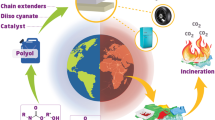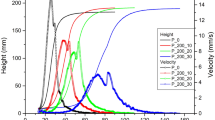Abstract
Flexible polyurethane foams can be advantageously treated by two-phase glycolysis in order to recover polyols with improved quality. The bottom phase obtained, which contains highly toxic reaction by-products and the excess glycol, presents an environmental and economic problem which should be solved. The main purpose of this work is the development of process for the valorization of these by-products, converting them in non-dangerous and profitable substances. For this process, most of the glycol can be recovered by means of vacuum distillation in order to reuse it in the glycolysis. On the other hand, the vacuum residue, containing the isocyanate part of the glycolysis by-products, was assayed as initiator in the synthesis of new polyols. Propoxylation of the initiator was carried out in different experimental conditions to obtain several polyether-polyols. Rigid polyurethane foams with suitable technical properties were synthesized with those polyols synthesized with the dangerous glycolysis by-products.






Similar content being viewed by others
References
Datta J (2010) Synthesis and investigation of glycolysates and obtained polyurethane elastomers. J Elastomers Plast 42:117–127
Datta J (2012) Effect of glycols used as glycolysis agents on the chemical structure and thermal stability of the produced glycolysates. J Therm Anal Calorim 109:517–520
Nikje A, Mohammad M, Nikrah M, Mohamadi H (2008) Microwave-assisted polyurethane bond cleavage via hydroglycolysis process at atmospheric pressure. J Cell Plast 44:367–380
Nikje A, Mohammad M, Haghshenas M, Garmarudi AB (2007) Split-phase glycolysis of flexible PUF wastes and application of recovered phases in rigid and flexible foams production. Polym Plast Technol Eng 46:265–271
Benes H, Rösner J, Hooller P, Synková H, Kotek J, Horák Z (2007) Glycolysis of flexible polyurethane foam in recycling of car seats. Polym Adv Technol 18:149–156
Borda J, Pásztor G, Zsuga M (2000) Glycolysis of polyurethane foams and elastomers. Polym Degrad Stab 68:419–422
Bakirova IN, Vluev VI, Demchenko IG, Zenitova LA (2002) Chemical structure and molecular mass characteristics of products in the glycolysis of a flexible poly(urethane) foam. Polym Sci Ser A 44:615–622
Molero C, de Lucas A, Rodríguez JF (2006) Recovery of polyols from flexible polyurethane foam by “split phase” glycolysis: glycol influence. Polym Degrad Stab 91:221–228
Molero C, de Lucas A, Rodríguez JF (2006) Recovery of polyols from flexible polyurethane foam by “split phase” glycolysis with new catalysts. Polym Degrad Stab 91:894–901
Molero C, de Lucas A, Rodríguez JF (2008) Recovery of polyols from flexible polyurethane foam by “split phase” glycolysis: study on the influence of reaction parameters. Polym Degrad Stab 93:353–361
Molero C, de Lucas A, Rodríguez JF (2009) Activities of octoate salts as novel catalysts for the transesterification of flexible polyurethane foams with diethylene glycol. Polym Degrad Stab 94:533–539
Molero C, de Lucas A, Rodríguez JF (2009) Glycolysis of flexible polyurethane wastes using stannous octoate as the catalyst. J Mater Cycles Waste Mang 11:130–132
Simón D, García MT, de Lucas A, Borreguero AM, Rodríguez JF (2013) Glycolysis of flexible polyurethane wastes using stannous octoate as the catalyst: study on the influence of reaction parameters. Polym Degrad Stab 98:144–149
Molero C, de Lucas A, Rodríguez JF (2008) Influence of the use of recycled polyols obtained by glycolysis on the preparation and physical properties of flexible polyurethane. J Appl Polym Sci 109:617–626
Ravey M, Pearce EM (1997) Flexible polyurethane foam. I. Thermal decomposition of a polyether-based, water-blown commercial type of flexible polyurethane foam. J Appl Polym Sci 63:47–74
Modesti M (1996) Recycling of polyurethane polymers. Adv Urethane Sci Techno 13:237–288
Pérez-Collado M, Molero C, Larrondo F, Sánchez P, Rodríguez L, Rodríguez JF (2005) Removal of caesium catalyst from polyols by ion exchange on Amberlite 252. React Funct Polym 64:139–150
ASTM D-4274-88 (1988) Standard test methods for texting polyurethane raw materials: determination of hydroxyl numbers of polyols
Pielichowski K, Kulesza K, Pearce EM (2003) Thermal degradation studies on rigid polyurethane foams blown with pentane. J Appl Polym Sci 88:2319–2330
Sendijarevic V (2004) Chemical recycling of mixed polyurethane foam stream recovered from shredder residue into polyurethane polyols. Polyurethanes 2004 conference, Las Vegas
Sheratte MB (1978) Process for converting the decomposition products of polyurethane and novel compositions thereby obtained. US Pat 4.110.266
Van der Wal HR (1994) New perspectives for the chemical recycling of polyurethanes. Paper 53. UTECH 94 Conf, The Hague
Van der Wal HR (1993) Process for conversion of polyurethane polymer to polyol and fresh polyurethane polymer therefrom. US Pat. 5.274.004, 1993
Pérez M (2004) High molecular weight polyether polyols: synthesis and catalyst removal. Doctoral Thesis, Castilla-La Mancha University
de Lucas A, Rodríguez L, Pérez-Collado M, Sánchez P, Rodríguez JF (2002) Synthesis of polyols by anionic polymerization: determination of kinetic parameters of propylene oxide polymerization using caesium and potassium alcoholates. Polym Int 51:1066–1071
Acknowledgments
Financial support from REPSOL-YPF SA and the CICYT project Ref. CTQ2008-06350 is gratefully acknowledged. We also acknowledge Spanish MEPSYD for provision of aFPU grant AP2010-6008 to Diego Simón.
Author information
Authors and Affiliations
Corresponding author
Rights and permissions
About this article
Cite this article
Simón, D., Borreguero, A.M., de Lucas, A. et al. Novel polyol initiator from polyurethane recycling residue. J Mater Cycles Waste Manag 16, 525–532 (2014). https://doi.org/10.1007/s10163-013-0205-y
Received:
Accepted:
Published:
Issue Date:
DOI: https://doi.org/10.1007/s10163-013-0205-y




